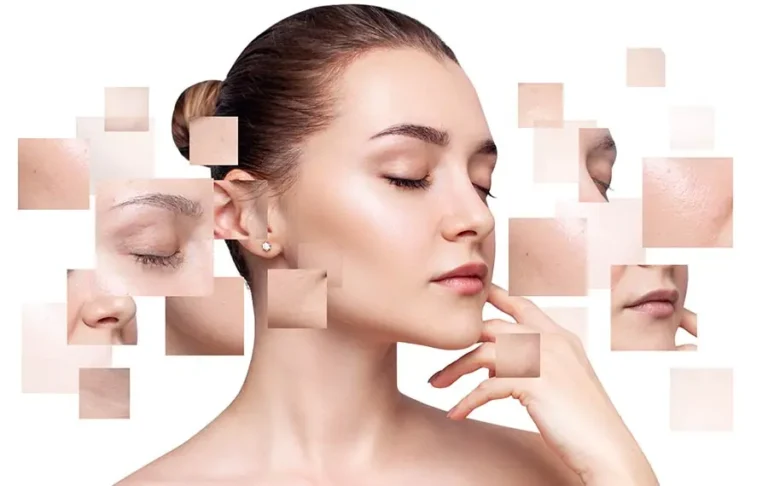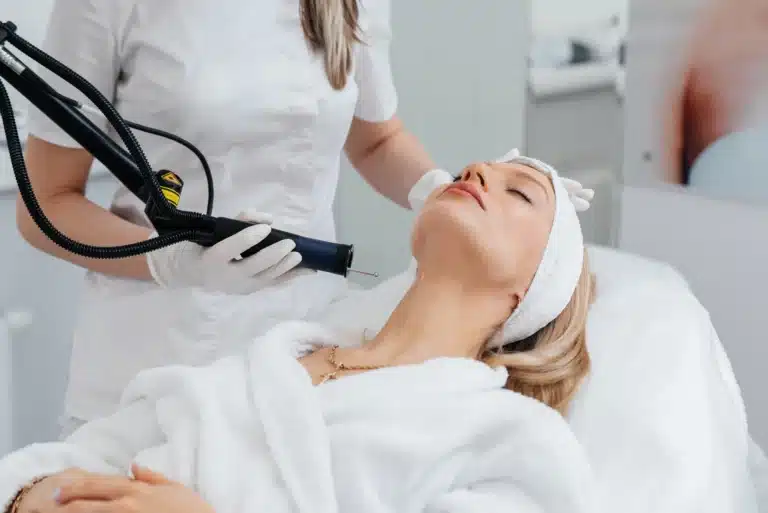Home » Conditions » Skin & hair » Sun spots
Age spots, also called solar lentigines, are flat, round pigmentations with well-defined edges that appear mainly on areas of the skin exposed to the sun, such as the face, the hands, the arms and the shoulders. They appear as small brownish or black spots, often mistaken for moles, but their origin is quite different.
They are a localized deposit of melanin, the pigment that gives color to the skin. The pigment is superficial, located in the epidermis. The color may be light (pale beige) or darker. Their number increases over time, and hypopigmentations (lighter spots) called actinic hypomelanosis are often associated.
These spots are generally harmless and appear as the skin ages or after prolonged exposure to the sun. However, their presence can be a source of aesthetic discomfort for many people, prompting them to seek solutions to reduce or eliminate them.
Age spots, also called solar lentigines, are brown spots that appear with age and sun exposure. These pigment spots, often located on the face, hands and décolleté, can dull the skin’s radiance and give an impression of aging. There are effective solutions to
reduce or eliminate age spots. Laser treatment is the most effective .
It is possible to regain an even, radiant and rejuvenated skin thanks to personalized treatments targeting lentigines and signs of aging.

The main cause of age spots is exposure to ultraviolet ( UV ) rays from the sun or tanning beds. UV rays damage the skin cells called melanocytes, which are responsible for producing melanin, the pigment that gives the skin its color. The melanocytes, once dysregulated, begin to produce more melanin. Over time, this excessive UV exposure leads to an accumulation of pigment, causing the appearance of brown spots.
Other factors can also contribute to their appearance :
Unfortunately, the melanin deposit does not disappear spontaneously. It is important to know that current techniques can eliminate the pigment but cannot correct the activity of melanocytes, so recurrences are constant. It is recommended to avoid sun exposure to prevent the reappearance of these pigmentations. The sun is moreover the main factor in skin aging and the appearance of skin cancers.
It is important to treat age spots when they become aesthetically bothersome or when they show an unusual evolution. Indeed, some pigment lesions that look like simple spots can sometimes correspond to more serious skin conditions, such as melanoma. It is recommended to consult a doctor if a spot changes color, shape or size, or if it begins to itch, bleed or become painful.
Several medical treatments can help reduce or eliminate age spots.
The fractional laser acts directly on the pigment, fragmenting the melanin without damaging the surrounding tissues.
Chemical peels use acidic solutions to exfoliate the skin and gradually reduce pigmentation.
Cryotherapy consists of freezing the spot with liquid nitrogen in order to destroy it.
Depigmenting creams, on the other hand, can lighten the spots thanks to active ingredients such as hydroquinone or retinoids.
According to Dr. Romano, laser treatment is the most effective and best tolerated ; it is moreover the only technique the doctor uses for this indication.
Many patients wish to remove pigment spots.
This is an exclusively aesthetic request, however these pigmentations must be monitored to ensure that there is no malignant evolution. Lentigines are not precancerous lesions, but a skin cancer can occur on any area of the body, even on a spot.
Several aesthetic-oriented medicine techniques make it possible to get rid of sun spots.
Several types of laser can be used :
A single session is generally sufficient. After the treatment, slight redness may persist on the spot for about one week.

The ablative laser treatment is performed in a medical office. The area concerned is first disinfected and, if necessary, a numbing cream may be applied to make the session more comfortable. The laser beam then targets the pigment, which is gradually vaporized.
The duration of the treatment depends on the number of spots and the extent of the area to be treated ; removing a spot usually takes only one minute.
Slight redness and swelling may appear immediately after the session, resembling a mild sunburn. These reactions are normal and disappear within a few days. A soothing cream is applied at the end of the treatment.
Before starting an ablative laser treatment for age spots or sun spots, certain precautions are essential to prepare the skin and limit the risk of complications.
After an ablative laser treatment, the skin requires special care to ensure good healing and avoid complications.
• Apply a soothing cream : right after the session, a healing or soothing cream (generally containing panthenol or hyaluronic acid) will be prescribed to accelerate healing. Apply it several times a day.
• Avoid sun exposure : direct sun exposure must be strictly avoided for at least four weeks after the treatment. When going outside, use a broad-spectrum sunscreen with a high SPF (50+). This prevents the risk of post-inflammatory hyperpigmentation.
• Do not pick at scabs : after the session, scabs may form on the skin. It is essential not to scratch or remove them, as this could cause scarring or infections. The scabs will fall off on their own after a few days.
• Gentle skin cleansing : use gentle cleansers without alcohol or fragrance to wash the treated area. Avoid exfoliants or scrubs during the healing period, which usually lasts 7 to 10 days.
• Consult in case of reaction : if there is persistent redness, swelling or signs of infection (pus, severe pain, warmth), consult your doctor.
The results depend on the type of treatment chosen. Laser treatment often eliminates the spots in one to two sessions, while peels require several sessions to achieve a similar result. In both cases, the skin gradually becomes more even, radiant and uniform. However, it is essential to strictly follow the sun protection instructions after the treatment, in order to prevent the reappearance of the spots.
Sun spots, or lentigines, can be effectively reduced thanks to medical treatments performed in a clinic in Geneva. The price of a session starts at 300 CHF, whether it is a peel or a pigment laser.
The choice of technique depends on the location of the lesions, their duration and the skin type. The number of sessions is adjusted according to the clinical response observed.
Patients who have chosen ablative laser treatment to reduce age spots or sun spots are, overall, very satisfied with the results obtained.
They report a noticeable improvement in the clarity and evenness of their complexion after just one session. Some patients mention slight discomfort or temporary redness after the session, but these side effects are generally well tolerated and disappear quickly. The treatment is considered an effective way to restore younger and more radiant skin, particularly appreciated for its minimally invasive nature.
The fast results and relatively short recovery time make it a preferred treatment for patients seeking a durable and effective aesthetic solution for age spots.
Some natural remedies can help slightly reduce the appearance of age spots, even though they do not replace targeted aesthetic treatments. Among them, aloe vera gel, appreciated for its soothing and regenerating properties, can help improve the appearance of the skin and gradually fade pigment spots.
To identify a suspicious spot, it is important to follow the ABCDE rule :
• Asymmetry : one half of the spot does not look like the other.
• Borders : the edges are blurred, irregular or notched.
• Color : the spot shows several shades (brown, black, red, white).
• Diameter : a size greater than 6 mm may be suspicious.
• Evolution : any rapid change in size, shape or color should be a warning.
In case of doubt, it is essential to consult a dermatologist for an accurate diagnosis.
Age spots, also called solar lentigines, are flat marks, brown to black in color, that appear mainly on sun-exposed areas (face, hands, décolleté). They are regular, painless, and do not change shape or color quickly.
Age spots are benign and stable over time. They have well-defined edges, a uniform color, and do not evolve rapidly. In contrast, a cancerous spot, such as melanoma, has irregular borders, changes in color, and evolves quickly. In case of doubt, a medical consultation is essential.
Yes, age spots can darken or become more numerous over time, especially in cases of excessive sun exposure. However, they do not turn into cancer. If a spot suddenly changes in appearance, it is recommended to consult a dermatologist.
In general, age spots appear mainly on areas frequently exposed to the sun. However, natural skin aging can sometimes lead to the appearance of spots on less exposed areas, although this is more rare. Good sun protection helps limit their development.